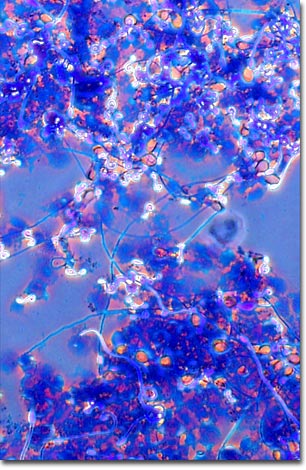Phase Contrast Image Gallery
Hydra Nematocysts
Hydras are tiny, simple invertebrates commonly studied by beginning biology students. They belong to the phylum Cnidaria, which includes corals, sea anemones, and jellyfish. Unlike most cnidarians, which are marine animals, hydras are found in freshwater ponds, lakes, and streams.

Hydras are also atypical because they do not have a medusa (jellyfish) stage as part of their life cycle as do most other cnidarians. They live and reproduce sexually and asexually, but only in the tube-shaped polyp form. However, they do have nematocysts, or cnidae, the microscopic intracellular stinging capsules characteristic of this phylum and for which it is named. Simple as these organisms are, the nematocysts are one of the most complex structures in the animal world.
Nematocysts are produced by nematoblasts, or cnidoblasts, and are used for capturing and paralyzing prey or for defense. Each nematocyst contains a coiled, hollow thread that can have barbs or spines and often contains poison. Under the appropriate stimulation, it is everted from the capsule, poisoning or entangling the organism's victim. Stings from large jellyfish, such as the Portuguese man-of-war can be extremely painful to humans and may cause paralysis, shock, or even death.
Hydras have four types of nematocysts on their tentacles and ectoderm (outer layer of cells), which are used for a variety of purposes. The largest nematocyst has barbs on the end that anchor the prey to the tentacle from which it was fired. With a firm hold on its prey, the hydra then envelopes the organism, like a sock being pulled over a foot, and consumes it. The second type is smaller and has a shorter, thicker corkscrew thread that wraps around and holds onto the prey animal. A third type has a sticky bean-shaped object at its end that is used in locomotion, securing the hydra as it glides or somersaults from one place to another. The forth kind of nematocyst has spines running along the thread and is probably used to defend the hydra against potential predators.
BACK TO THE PHASE CONTRAST GALLERY
